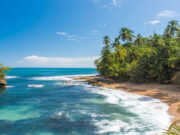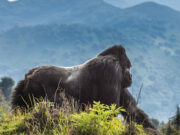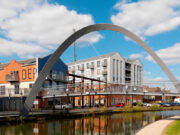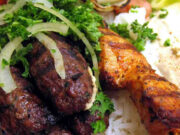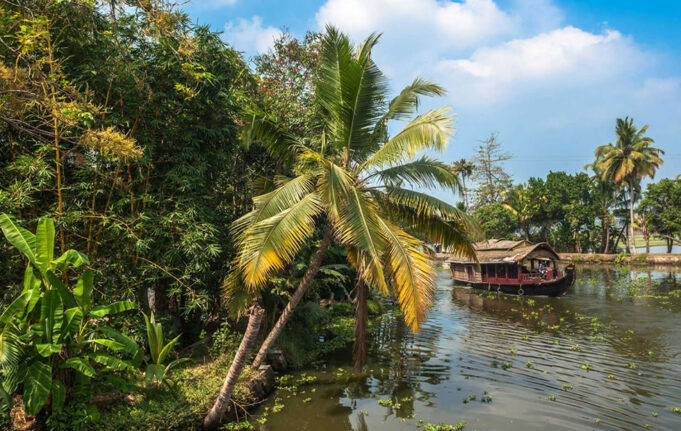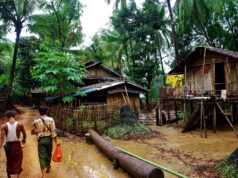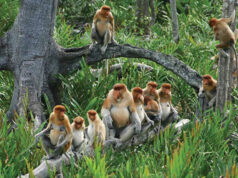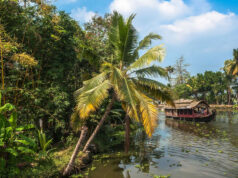Sue Bryant discovers a slice of heaven in India’s tropical deep south
We arrived in Kerala on one of those bleary-eyed night flights, the kind when you’re so tired you no longer know or care what day it is, bumping off the airport highway onto endless dirt roads, the silhouettes of coconut palms shadows in the moonlight. We stole into Purity, our lakeside villa, in the darkness, like thieves, greeted by a sleepy night watchman.
I woke to bright sunlight streaming through the window and stood on my balcony blinking at the brilliant colours of rural India: scarlet flame trees, red and yellow hibiscus, pinky-white frangipani. At the end of the villa’s garden, the vast expanse of Lake Vembanad, India’s longest lake, shimmered metallic grey in the morning heat. Fishermen in loincloths, nets heaped high on their dugouts, were returning with the morning’s catch. Great rafts of purple water hyacinth formed islands on the lake. Kerala dubs itself ‘God’s own country’ – and I could see why.
Shaking off the journey and the stress of London life was no trouble in this exquisite spot. We flopped around in the infinity pool and dozed in the shade. I had an ayurvedic massage which I can only describe as extreme; no whale music and Western spa modesty here. I slithered out, dazed and still drenched in oil, a bindi on my forehead and curry powder in my hair.
Later that evening, we toasted the sunset with an excellent Indian rosé while some of our fellow guests went out with a fisherman in his dugout to admire the Chinese fishing nets, complex wooden structures characteristic of this area, cantilevered over the water’s edge.
Malabar Escapes, which owns Purity, has several villa hotels in Kerala, designed to visit in a circuit with maximum contrast and minimum time on the road. We headed away from the coast, driving through densely vegetated countryside, the air like a warm bath. The roadsides were lined with traders; stalls selling heaps of watermelons, great bunches of bananas and chickens in cages.
jasmine in the air
Serenity is a grand old plantation house situated on top of a hill overlooking a dense rubber plantation, set in pretty gardens filled with exotic bushes, the scent of jasmine in the air and a small, green swimming pool looking out towards the distant hills. We went on a plantation walk to learn about how the rubber is tapped; it’s laborious work, collecting the sticky, white liquid every day. A visit to a local house was an education; I realised that Keralan gardens, while appearing random and messy, actually feed the whole family. Every plant has a use: coffee, cinnamon, nutmeg, mango, papaya, pineapple, coconut, banana and allspice. Dinner that night embraced plenty of the local produce; curries of fish, tomato and coconut, followed by platters of delicious fruit, all washed down with another highly respectable Indian wine.
There was great excitement the following day when Lakshimi, a 42-year-old elephant, arrived at Serenity with her mahout. She’d been ‘hired’ for the day by a family we met as a gift to their three boys, who would learn to wash Lakshimi, walk her and ride on her, a break from her day job of hauling logs. She gazed at us serenely from under long eyelashes as we ran around, snapping away like paparazzi.
Our last night ashore was spent at The Malabar House, the hippest address in Fort Kochi, the crumbling old colonial part of Cochin. A little oasis in turquoise and coral, dotted with statues, silk wall hangings, erotic art and koi ponds, Malabar House is blissfully romantic, although shopping aside, I wouldn’t rush back to scruffy Fort Kochi. I was anxious to get out on the lake and the next stage of our journey was by boat.
Lake Vembanad is part of India’s largest wetland system, fed by the monsoon rains cascading down from the hills and kept fresh by a long, saltwater barrier regulating the amount of seawater that gets in. There are hundreds of houseboats mooching around the sleepy backwaters here, although we sailed in splendid style, on the Oberoi MV Vrinda, a beautiful boat carrying 16 guests and belonging to India’s poshest hotel chain, Oberoi Hotels.
Vrinda is a distinct contrast from the chaos on the quayside of cars, motorbikes, wandering cows and salesmen touting peacock feather fans and carved coconut shells; more a world of ice-cold hand towels and freshly squeezed pineapple juice. The captain cast the ship’s lines and we chugged out onto the lake, the horizon fading into a white sky in the heat of the afternoon. Cormorants perched on the hyacinth islands and eagles wheeled overhead. Chanting from a distant Hindu temple echoed across the water. Gin-and-tonic hour came and went swiftly before mosquitoes drove us indoors, but I wasn’t complaining; the food, all magnificent Keralan specialities, was delicious, rich with coconut and spice. One day, we were served an 18-course wedding banquet presented on banana leaves – and that was just for lunch.
Our fellow guests were a mixed bag: a young Austrian couple, two British retirees who were chilling on the lake after a strenuous tour of Rajasthan, and a group of very elegant Belgian women who were touring India by private jet. Their husbands, we learned, were in diamonds.
a flash of turquoise
Every day, we’d leave our mother ship (which is too tall to fit under the low-hanging power lines that cross the canals) and head into the backwaters on a rice barge. Under the tutelage of the charmingly formal Mr Joyce, our guide, we visited an eclectic range of sights, not least a third-generation wood carver, who produces Virgin Marys and life-sized crucifixion scenes, painted in lurid colours and with an order book extending worldwide.
We stopped at a ‘secret’ boatyard where a crew of workers was building a snake boat. These 130ft vessels are made of solid jackwood and rowed by a crew of 100 in inter-village races in August, which is a huge event. This particular boat was costing 2.2m rupees (£22,250) to build. As a mark of respect for the tradition it represents, a sign read: “No shoes in the yard, no photos, no smoking and no swearing”.
The canals themselves are still and tranquil, the only movement a flash of turquoise as a kingfisher dives for its catch, or the occasional blur of burnt orange or shocking pink as sari-clad women thrash washing against the rocks. The reality, though, is a setting of constant industry, some of it tough. Untouchables in loincloths dive down into the muddy water and forage for clams in the silt. The clams are eaten and the shells ground up to make cement. The rice paddies are harvested by hand and mallards from the many duck farms are brought in to peck at the seeds left over and fertilise the soil, before they’re carted off to market.
Money sent home from the grim construction sites of the Gulf has allowed Keralan families to build grand, marble-lined mansions along the canals. Soon, Mr Joyce told us, the rice paddies will be harvested by machine, which is just as well, as young people now aspire to get out of India and earn a tax-free income in Qatar or Abu Dhabi, and there won’t be anybody left to do the manual jobs. It’s sad, the way families are torn apart in the name of progress, but even in God’s own country, paradise has its price.




